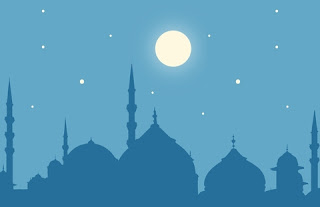
|
Asked Bulukiya, "And hath Allah created other mountains behind the mountain Kaf?"
Whereto the angel answered, "Yes, behind this mountain is a range of mountains five hundred years' journey long, of snow and ice, and this it is that wardeth off the heat of Jahannam from the world, which verily would else be consumed thereby.
"Moreover, behind the mountain Kaf are forty worlds, each one the bigness of this world forty times told, some of gold and some of silver and others of carnelian. Each of these worlds hath its own colour, and Allah hath peopled them with angels, that know not Eve nor Adam nor night nor day, and have no other business than to celebrate His praises and hallow Him and make profession of His Unity and proclaim His Omnipotence and supplicate Him on behalf of the followers of Mohammed (whom Allah bless and keep!)" -- From The Voyage of Buluqiya, The Arabian Nights
It is only fitting that I begin a blog named after Scheherazade with a review of the One Thousand and One Arabian Nights -- or the One Thousand and One Nights, or The Arabian Nights, as it is variously called.
I read the book way back in sixth grade. I enjoyed it, though many of the stories confused me--particularly the ones where Sinbad talked to himself, and anything involving flying "rocks."
(Birds. Rocs are birds.)
But sixth grade was a long time ago, so I decided I'd better read it again, especially since djinn feature rather prominently in the novel I'm working on. But more on them later.
The Nights is a collection of Middle Eastern folk and fairy tales with a complicated pedigree. No one knows exactly when the Nights was first penned, or by whom. The original has been lost in the sands of time, if we can even speak of an "original." The first edition drew on folklore that existed long before its author put quill to parchment, but it is the frame story of the vengeful, murderous king and his brave wife Scheherazade that makes The Nights The Nights.
The oldest surviving manuscript fragment, "The Book of the Tale of the Thousand Nights" hails from ninth-century Syria. Since the original was most likely Persian, not Arabic, ("Scheherazade" is a Persian name,) the book most likely was already in wide circulation by that time.
The next clue pops up a century later, but only in reference. A bookseller's catalogue includes the Persian Hezār Afsān or "The Thousand Stories," noted to contain the frame narrative of Scheherazade trying to escape death by placating the king with a different story each night. Unfortunately, no copies of the Hezār Afsān remain.
The Nights pops up again in 12th century Cairo. Two different translations appear, with new stories in each. From here on versions multiply as the book becomes more popular and people add more tales. There is no one, "true" edition, but many different books, all descended from the original like a river splitting into dozens of rivulets as it meets the sea.
The stories, of course, reflect the times and places where they were written. You can't really escape that, for all things do. Slaves are tortured, women are murdered for infidelity--or its mere suspicion--and stereotypes, yes, abound. Yet there are some wonderful stories in the collection, about magical flying horse-machines, water-people who live beneath the sea, alien worlds, fairy princesses, talking birds, djinn, and a great many besotted lovers.
I like to imagine that Scheherazade was a real person, the author of the book, a woman who put quill to paper centuries ago. Perhaps she intended the book to be more than just a collection of tales. Perhaps she wanted recognition as a story teller. Both the frame story and many of the tales within focus on marital infidelity and resulting spousal rage. Perhaps she wanted to push her readers toward sympathy and compassion toward star-crossed lovers, and women in particular.
Perhaps...
We will never know, of course.
But the river keeps on flowing,
And the tales keep on spinning,
And the wind keeps on blowing,
To the dark and briny sea.
I love how stories build. Generations of tale-tellers take what came before them and add to it. Stories are never static. Their streams don't just branch; they merge and go underground and bubble up again in unfamiliar places, creating something new -- yet familiar -- each time.
With thanks to Mohamed Hassan for the picture.
Comments
Post a Comment